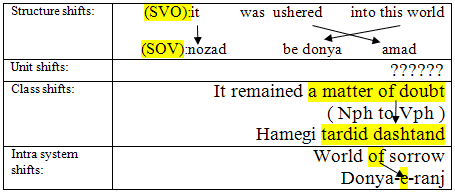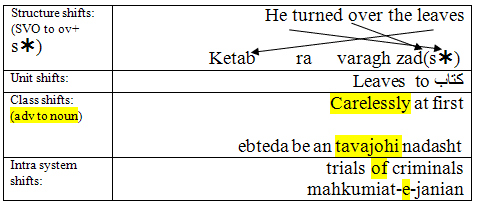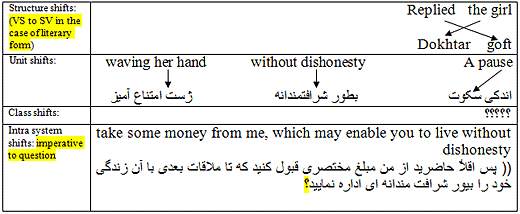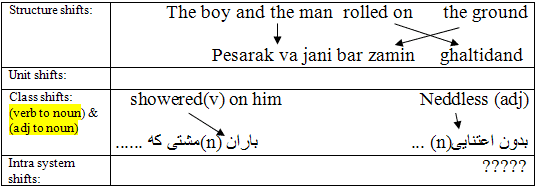Become a member of TranslationDirectory.com at just 8 EUR/month (paid per year)
Abstract
Current study aims at finding the realization of J.C Catford’s category shifts (structure shift, unit shift, class shift, intra-system shift) in the Persian Translation of Oliver twist. The Ideal goal of this study however is to find the areas in which Persian is deviated from English and to pave the way for future studies which are to formulate manners for translating from Persian into English plus distinguishing obligatory shifts from optional shifts via the application.
Keywords
Catford’s Shifts, scrutinizing, category shifts, application, optional shifts, obligatory shifts.
 Among
many of the translation studies some whose focuses were on the text
alone concentrated on the formal changes rather than meaning e.g. catford’s
shifts, transpositions by Vinay and Darbelnet, etc. Translation as an
interlingual practice necessitates moving from the form of the SL to
the TL. In other words translation is a change of form (Larson 1984:
2 ) and this formal change takes place at different levels within a
text.
Among
many of the translation studies some whose focuses were on the text
alone concentrated on the formal changes rather than meaning e.g. catford’s
shifts, transpositions by Vinay and Darbelnet, etc. Translation as an
interlingual practice necessitates moving from the form of the SL to
the TL. In other words translation is a change of form (Larson 1984:
2 ) and this formal change takes place at different levels within a
text.
studies done in this area had named the phenomenon differently e.g. skewing (Larson 1984), Transposition ( Vinay and Darbelnet1995, 2000 ), shifts ( JC Catford 1965 ). From which some were prescriptive and practice- oriented, trying to formulate these shifts from one language to another. However, from the mentioned studies and terms used to refer to formal changes, Catford’s shifts are focused more than others in this study since they provide us with a more organized and systematic classification of such changes.
Vinay and Darbelnet (1995) introduce the term “transposition” as one of the four procedures of oblique translation and define it as the following:
- Transposition: this is a change of one part of speech for another without without changing the sense (Vinay and Darbelnet, 2000 as cited in baker, 1998)
Although, Vinay and Darbelnet did not use the term “shift” in their definition of the formal changes, they referred to the same phenomenon in translation as is referred by Catford (1965) who is known as the pioneering theorist of “shifts”. Shifts are defined by J.C Catford as ‘the departures from formal correspondence in the process of going from the SL to the TL’ and are classified as the level shifts and category shifts. This study However had focused on the category shifts which are defined as the followings.
- Structure-shifts. These are amongst the most frequent category shifts at all ranks in translation; they occur in phonological and graphological translation as well as in total translation. 1.211 In grammar, structure-shifts can occur at all ranks. The following English- Gaelic instance is an example of clause-structure shift.
- 1.23 Unit-shift. By unit-shift we mean changes of rank—that is, departures from formal correspondence in which the translation equivalent of a unit at one rank in the SL is a unit at a different rank in the TL. Class-shifts. Following Halliday, we define a class as “that grouping of members of a given unit which is defined by operation in the structure of the unit next above”. Class-shift, then, occurs when the translation equivalent of a SL item is a member of a different class from the original item.
- Intra-system shift. In a listing of types of translation-shift, such as we gave in 1.2 above, one might expect “system-shift” to occur along with the names of the types of shift affecting the other fundamental categories of grammar—unit, structure and class.
The most detailed attempt to produce and apply a model of shift analysis has been carried out by Kitty van Leuven-Zwart (1989, 1990) of Amesterdam whose model takes some of the categories proposed by Vinay and Durbelnet and Levy and applies them to the descriptive analysis of translation, attempting both to systematize comparisons and to build in a discourse framework above the sentence level (Mundy 2001: 63)
Method
Six paragraphs were selected randomly from the whole novel (fifty chapters). And the shifts were applied on them by means of tabulations and arrows. Finally a conclusion is made on the shifting areas in translating from English into Persian. The realization of structure shifts are demonstrated in terms of S (subject), O (object), V (verb) and p (predicate). The focus of intra-system shift is on the realizations through the occurrences of possessive forms in both languages.
The application
In this section all samples are analyzed and observed for instances of the realization of category shifts.
Sample 1): For a long time after it was ushered into this world of sorrow and trouble, by the parish surgeon, it remained a matter of considerable doubt whether the child would survive to bear any name at all; in which case it is somewhat more than probable that these memoirs would never have appeared; or, if they had, that being comprised within a couple of pages, they would have possessed the inestimable merit of being the most concise and faithful specimen of bi- ography, extant in the literature of any age or country.
پس از اینکه نوزاد به کمک جراح محل به این دنیای رنج و اندوه آمد تا مدت ها بعد همگی تردید داشتند که بچه زنده بماند و لزومی داشته باشد که برایش نامی بر گزینند. و در آنصورت محققاً این یاد داشت ها نیز هرگز به نظر کسی نمیرسد و اگر هم قرار می شد. آن را تدوین کنند در یکی دو صفحه می توانست به صورت شرح حال موجز و دقیقی در ادبیات هر عصر و کشوری خود نمایی کند.

Sample 2): What was Oliver’s horror and alarm as he stood a few paces off, looking on with his eyelids as wide open as they would possibly go, to see the Dodger plunge his hand into the old gentleman’s pocket, and draw from thence a hand- kerchief! To see him hand the same to Charley Bates; and finally to behold them, both running away round the corner at full speed!
ناقلا دست خود را در جیب پیر مرد فرو برد و از آن دستمالی بیرون کشید، به دست چارلی داد و آنگاه هر دو با نهایت سرعت به گوشه ای گریختند.

Sample 3): He turned over the leaves. Carelessly at first; but, lighting on a passage which attracted his attention, he soon became intent upon the volume. It was a history of the lives and trials of great criminals; and the pages were soiled and thumbed with use. Here, he read of dreadful crimes that made the blood run cold;
کتاب را ورق زد، ابتدا به آن توجهی نداشت ولی ناگهان چشمش به عباراتی افتاد که نظر او را به سختی جلب کرد. این کتاب، تاریخ زندگی و محکومیت جانیان بزرگ بود، صفحات آن بر اثر ورق زدن زیاد و دست به دست گشتن کثیف و سائیده شده بود. در آن کتاب ماجرای جنایاتی را خواند که خون را در عروق منجمد می ساخت.

Sample 4): The momentous interview was no sooner concluded, and Oliver composed to rest again, than the doctor, after wiping his eyes, and condemning them for being weak all at once, betook himself downstairs to open upon Mr. Giles.
تازه این ملاقات به پایان رسیده و الیور از نو به خواب رفته بود که دکتر پس از پاک کردن چشمان خود و بر طرف ساختن ناراحتی عارضه، پائین آمد تا بی درنگ بر آقای جیل حمله ور شود. و همین که در سالن ها هیچ کس را ندید فکر کرد می تواند فوراً عملیات را به نحو موثری در آشپزخانه آغاز نماید. به همین علت به سوی آشپز خانه راه افتاد.

Sample 5): You will,’ said Rose, after a pause, ‘take some money from me, which may enable you to live without dishonesty—at all events until we meet again?’ ‘Not a penny,’ replied the girl, waving her hand.
رز پس از اندکی سکوت گفت: (( پس اقلاٌ حاضرید از من مبلغ مختصری قبول کنید که تا ملاقات بعدی با آن زندگی خود را بطور شرافت مندانه ای اداره نمایید؟)) دختر با ژست امتناع آمیزی گفت : (( به هیچ وجه))

Sample 6):
The three spectators seemed quite stupefied. They offered no interference, and the boy and man rolled on the ground together; the former, heedless of the blows that showered upon him, wrenching his hands tighter and tighter in the garments about the murderer’s breast, and never ceasing to call for help with all his might.
هر سه نفر تماشا چی این صحنه مبهوت مانده بودند، حتی کوچکترین حرکتی هم برای دخالت نکردند و پسرک و جانی با هم بر زمین غلتیدند و پسرک بدون اینکه اعتنایی به باران مشتی که بر سر و کله اش فرود می آمد داشته باشد، دست های خود را محکم در میان جامه هایی که سینه ی جانی را پوشانده بود فرو کرده و مرتب برای استمداد فریاد می کشید

Concluding remarks:
As is evident, in translating from English to Persian structural shifts tend to occur everywhere within the text. However there were some instances of exception in literary forms e.g. in samples 3,4and 5. Unit shifts tended to happen rarely in the translation of this work. And intra-system instances tended to occur in most samples. According to Vinay and Darbelnet, transpositions are classified as optional and obligatory. The same is true about the catford shifts. According to the evidences, structure shifts and intra-system shifts can be classified as obligatory shifts since in the process of translating from English to Persian translator doesn’t have many structural choices and any alterations lead to a change in the style. Unit and class shifts following Vinay and Darbelnet (2000) can be classified as optional shifts in which the translator has some choices among two or more items. In other words unit shifts and class shifts are determinant of weather a translation is free or literal, covert or overt, semantic or communicative.
In translating from English into Persian one must be aware of the SVO structure of English and change it to SOV in Persian unless you decide to change the style as in sample 3 or follow the SL form as in sample 4 or make the subject implicit in verb as in sample 3. In the case of intra-system shifts one must be aware of both language’s systems and grammars to apply the shift correctly.
By defining more unit shifts to translation, it moves from literalness toward being free. Thus the translator on the basis of his intention(s) has the option to determine the kind of his translation by choosing among the alternatives such as the followings:
- To define or not define a shift
- To choose among the existing choices in the case of optional shifts
Future study
Further research can be performed to investigate the structure shifts in the case of literary translation where stylistic changes tend to make deviations from the normal structure. The same research can also be performed to investigate the structure shifts via the realization of passive structure within the translating process.
Sources:
Monday, j (2001). Introducing Translation Studies; theories and applications. Routhledge
Baker, M (1998). Routledge Encyclopedia of Translation Studies. routledge
Venuti,L.(2000) . The Translation Studies Reader, rothledge, Oxon
Larson,L(1984). Meaning Based Translation: A guide to Cross-Language Equivalence. University press of America, Lanham
http://www.translationdirectory.com/articles/article2108.php
